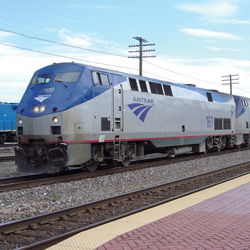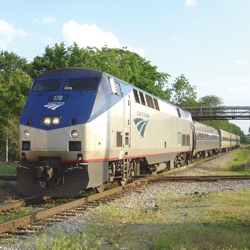
Exactly thirty years ago this past January, the last passenger train, the Peoria Rocket, departed from Peoria. Amtrak’s Prairie Marksman served East Peoria starting in August 1980, but service was discontinued a year later. After that, the closest Amtrak station was in Chillicothe, but service there ended in 1996. Since then, the Peoria area has been without passenger rail service. Today, the closest cities with Amtrak service are Normal and Galesburg.
But that may soon change. Thanks to the leadership of Mayor Jim Ardis and Senator Dick Durbin, Amtrak and the Illinois Department of Transportation (IDOT) are currently working on a feasibility study on restoring passenger rail service to Peoria from Chicago’s Union Station. The study, which is expected to be published this summer, will outline the potential demand, available routes, and estimated cost of bringing Amtrak to the Peoria area.
Why Bring Amtrak to Peoria?
Amtrak ridership is up nationwide, and Illinois is no exception to that trend. Amtrak reports that ridership on trains between Chicago and St. Louis “was up 16.5 percent in Fiscal 2008 over 2007. Ridership increased 18.5 percent on the Chicago-Carbondale route, was up 19.8 percent on the Chicago-Quincy route, and grew 25.9 percent on the Hiawathas.” This trend continues in 2009. In January, ridership between Chicago and St. Louis was up 12 percent over the same period in 2008, according to figures released by IDOT.
More people are choosing to travel by train, and more communities are requesting passenger rail access. Amtrak recently completed studies on adding train service to Rockford and the Quad Cities. Peoria, with the third-largest metropolitan statistical area in the state—over 370,000 residents—would be a natural addition as well.
Restoring passenger rail service to Peoria would connect our population to the national rail transportation system. Travelers from Peoria could go anywhere in the U.S. that Amtrak serves—and just as importantly, travelers from all over the U.S. could come to Peoria. Peorians traveling to Chicago by train would benefit from low fares (significantly cheaper than the cost of driving to and parking in Chicago) and no traffic congestion. By leaving the “driving” to Amtrak, transit time can be used for work or leisure. Likewise, college students, businessmen and women, and tourists will find Amtrak to be a convenient way to travel to Peoria and enjoy our community. Bringing Amtrak and its ridership into the community will have a positive economic impact on the region.
There are also environmental benefits to passenger rail service. The U.S. Department of Energy found that Amtrak is more energy-efficient than either automobile or commercial air travel. “Amtrak energy intensity was 2,935 British Thermal Units (BTUs) per passenger-mile and commercial airlines were 3,587. Commuter rail was 2,751 and automobiles were 3,549 BTUs,” according to the DOE’s Transportation Energy Data Book. By taking the train, we can lower the carbon footprint of our trips. It is simply more energy-efficient to take the train directly from Peoria than to drive to Chicago, or even Normal or Galesburg, to catch the train there.
 Nationally, a greater emphasis is being placed on sustainable transportation networks—with less dependence on the automobile, and thus, less oil consumption and dependence on imported oil—and passenger rail is part of that national strategy. Last October, Congress passed and the president signed the Passenger Rail Investment and Improvement Act of 2008, which authorized $13.1 billion for Amtrak over the next five years. The recent stimulus bill included $1.3 billion in additional Amtrak funding, as well as $8 billion for high-speed rail. Locally, Senator Durbin has been supportive of adding new service to Illinois cities and improving existing service, and the Tri-County Regional Planning Commission’s long-range transportation plan lists as a top priority: “connect with Amtrak.”
Nationally, a greater emphasis is being placed on sustainable transportation networks—with less dependence on the automobile, and thus, less oil consumption and dependence on imported oil—and passenger rail is part of that national strategy. Last October, Congress passed and the president signed the Passenger Rail Investment and Improvement Act of 2008, which authorized $13.1 billion for Amtrak over the next five years. The recent stimulus bill included $1.3 billion in additional Amtrak funding, as well as $8 billion for high-speed rail. Locally, Senator Durbin has been supportive of adding new service to Illinois cities and improving existing service, and the Tri-County Regional Planning Commission’s long-range transportation plan lists as a top priority: “connect with Amtrak.”
Finally, consider that transportation is an essential service, imperative for the safety and mobility of Illinois citizens. Improving our transportation options improves our overall infrastructure, and our economy benefits from the jobs brought by infrastructure improvement. The economy is also helped by making our city more attractive to potential employers and employees, who are increasingly looking for greener cities in which to live and work.
How Would Peoria Connect With Amtrak?
Under consideration are three possible routes. The cost and feasibility of each route will be included in the final study to be released this summer. Although we don’t know as of this writing what these conclusions will be, we do know some information about each route.
The first route is the one used by the old Peoria Rocket, which would come into downtown Peoria on the old Rock Island (now Iowa Interstate) tracks that run along Route 29. The train could possibly use the old Rock Island Depot (now known as the River Station) or the new Rock Island Depot (located by Constitution Garden at Morton and Bond streets). The latter depot is located where the City’s Economic Development department is interested in putting new townhouses and a street with a river view. There are several advantages to this route. It would be centrally-located for the region, two potential terminal buildings already exist, and it would bring the train into the heart of the city, which would support revitalization efforts there. The area is pedestrian-friendly and near other transportation options, such as city bus service. However, there are questions as to whether there would be enough available parking to support a depot downtown, and the cost of upgrading the old Rock Island tracks so they can support a 79-mph passenger train may be high.
The second possible route would be down the Union Pacific mainline on the northwest side of town. The train could terminate on the spur near Allen Road north of Pioneer Parkway. One advantage of this route is that the Union Pacific tracks are already suitable for passenger service. However, UP has quite a bit of freight traffic on this line which could cause delays for passenger trains. A new depot would have to be built if this route were chosen, but presumably there would be ample land available for parking. While the train would be near the growth area of the City, it would actually be terminating in an industrial park, and the only way out of the station would be by car—there is no bus stop, pedestrian access or restaurant/retail establishment nearby. This could give the rail passenger the feeling of being “stranded” upon arriving in Peoria.
The final possibility is to resurrect the old Prairie Marksman route, which would bring the train into East Peoria instead of Peoria. This route would follow the current Lincoln Service route from Chicago toward Normal, but would turn west either at Chenoa (bringing the train through Eureka and Washington), or Bloomington (bringing the train through Carlock and Goodfield). This route, similar to the Rock Island route, would have the advantage of being centrally-located, but would also have the same questions regarding parking availability. Depending on the termination point, however, a new depot could be constructed in a pedestrian-friendly area with adequate parking. For example, it could be incorporated into plans for East Peoria’s Downtown 2010 project. Track conditions between Chenoa and East Peoria are similar to those on the old Peoria Rocket route, and thus would need to be upgraded for passenger service. Track conditions are better between Bloomington and East Peoria.
One thing to keep in mind is that the long-term viability of these routes depends not primarily on track conditions and termination points—that just affects the cost of initiating service—but on ridership. When choosing a route, it’s important to consider the cities, towns, and villages through which the train will travel and how much ridership can be picked up from those communities. It’s best, if affordable, to pick a route with many towns that are not currently served by passenger rail to capture as much new ridership as possible.
Where Do We Go From Here?
Once the feasibility study is completed, local leaders will have some decisions to make. The first one, of course, is which route to pursue. Once that is determined, they will have to decide if there is enough support among the members of our community and other communities on the line to fund it. The money to fund it comes from a combination of state and federal dollars. Congress has increased funding to Amtrak, and that money can be used not only to improve existing service, but to expand it to new communities. The federal money is given to the states, which then decide on which rail projects to spend it.
That means, if we would like to see Amtrak service in Peoria, we must contact our state legislators and let them know. They are the ones who would need to secure the money necessary to make passenger rail service here a reality—and they’re only going to secure that money if they are convinced there is enough demand for it.
If this is something that interests you, I would encourage you to contact your state representatives and senators directly. And there is another way to let your voice be heard. The Peoria Passenger Rail Coalition is a new, grassroots organization that advocates on behalf of its members and the Greater Peoria Area for restored passenger rail service. Anyone can join, and membership is free. The mission is simple: to speak with one voice to governmental agencies and elected officials in favor of restored passenger rail service to Peoria, and to keep the community informed of progress being made toward that goal. You can get more information by visiting peoriarail.org.
Passenger rail service is still sometimes seen as the transportation system of the past. But in communities around the world, more and more people are recognizing it as the transportation system of the future. Access to passenger rail transit benefits communities economically, socially and environmentally. Let’s make those benefits part of Peoria’s future. iBi

